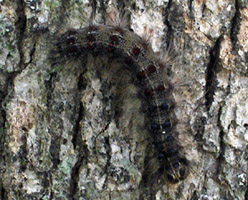NJDA SURVEY SHOWS GYPSY MOTH POPULATIONS REMAIN AT LOW LEVELS
Three Camden County Towns to Participate in 2011 Spray Program
For Immediate Release: January 5, 2011
Contact: Lynne Richmond
(609) 633-2954
(TRENTON) – New Jersey Department of Agriculture surveys of 148 New Jersey municipalities have found three areas in one county that qualify for the state’s Aerial Gypsy Moth Suppression Program for 2011.
The Department today proposed spraying a total of 343 acres in the Camden County towns of Chesilhurst, Waterford Township and Winslow Township.
“Even though we are seeing low gypsy moth populations at this time, we must remain vigilant with our surveillance and spray programs to keep those numbers down,” said New Jersey Secretary of Agriculture Douglas H. Fisher. “We have seen in the past how quickly populations can explode given the right conditions. We need to keep up our intense monitoring to suppress these tree-killing insects.”
Gypsy moth egg mass surveys were conducted from August to December in the 88 towns that requested them and an additional 60 towns outside the affected municipalities. From these surveys, it was determined that 69 acres in the Borough of Chesilhurst, 63 acres in Winslow Township and 211 acres in Waterford Township had high enough gypsy moth populations to qualify for the Department’s 2011 spray program. All three towns have opted to participate in the voluntary program this May.
To qualify for the spray program, a residential or recreational forest must have an average of more than 500 egg masses per acre and be at least 50 acres in size. A single egg mass contains up to 1,000 eggs.
There was no spray program in 2010. Last spring, Chesilhurst, Winslow and Waterford experienced 46 acres of defoliation by gypsy moth caterpillars, the only towns in Camden County to have tree damage from the invasive insects. In total, New Jersey had 3,813 acres of defoliation in 107 municipalities in 20 counties last year.
In contrast, 91,890 acres of trees were damaged by the caterpillars in 2009 and the Department’s spray program included 35,816 acres that year.
Two to three consecutive years of significant defoliation (defined as 75 percent or more) can kill an otherwise healthy tree. However, any gypsy moth defoliation can make trees more susceptible to other damage that can lead to the death of the tree. Oak trees are the preferred host for gypsy moths, but the caterpillars can be found feeding on almost any tree in the vicinity.
For more information on New Jersey’s gypsy moth suppression program, visit: www.nj.gov/agriculture/divisions/pi/prog/gypsymoth.html. Also, for national gypsy moth material, visit www.na.fs.fed.us/fhp/gm/.



